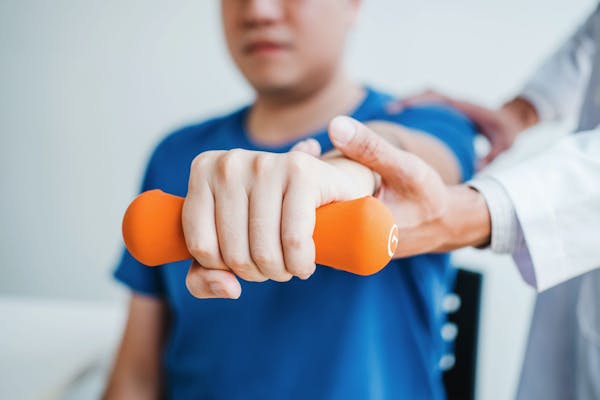Health Blog: Solutions & Wellness Tips
Physical Therapy May Have Same Outcomes For Shoulder Pain as Surgery

As we discussed in our first post, nearly 85% of shoulder conditions involve the rotator cuff, and among the most common of these is shoulder impingement syndrome (SIS). SIS results from the rotator cuff tendons becoming compressed—or “impinged”—as they pass through a small bone on top of the shoulder blade called the acromion. Over time, this causes the tendons to become irritated and inflamed, which eventually leads to bothersome symptoms like swelling and tenderness, loss of strength, restricted movement, and pain.
SIS is most prevalent in individuals that regularly perform lots of overhead activities like golfers, swimmers, baseball and tennis players, as well as painters and construction workers. The condition can also result from an injury that compresses the structures of the shoulder—like a fall—or from frequently sleeping on your side. Sleeping in this position regularly can strain the shoulder and cause impingement over time.
SIS is closely related to rotator cuff tendinitis and subacromial pain, and in some cases, the terms are used interchangeably. When any of these conditions develop, the best course of action is a comprehensive physical therapy program, which helps patients work through their pain to regain strength, flexibility, and physical function; however, many patients still opt to undergo a surgical procedure called arthroscopic subacromial decompression (ASD) to treat their shoulder pain. An abundance of research has shown that this procedure does not lead to any significant benefits, but it remains one of the most frequently performed procedures in the world, and some professionals still advocate for it. To better understand the outcomes of these patients, a study was conducted that compared the return–to–work rates for patients with subacromial pain who underwent different interventions.
Study periodically monitors more than 200 patients for 5 years
A total of 210 patients with subacromial pain for more than 3 months were enrolled in the study and randomly assigned to one of three treatment groups: exercise therapy, diagnostic arthroscopy, or ASD. Patients in the exercise therapy group underwent a supervised, individually designed physical therapy program that included daily home exercises and 15 visits to a physical therapy clinic. Patients in the diagnostic arthroscopy group underwent a “sham” procedure in which an examination of the shoulder was performed with a small camera inserted surgically, but no repairs were made to the shoulder. Patients in the ASD group were treated surgically with the ASD procedure, which involved the careful removal of some portions of bone and a structure called the bursa. Patients in the diagnostic arthroscopy and ASD groups also participated in a postoperative physical therapy program. All patients were assessed at the beginning of the study and then again 2 years and 5 years later.
Two years after these interventions, 78% of patients in the exercise group, 80% of patients in the diagnostic arthroscopy group, and 82% of patients in the ASD group were found to be actively working. Five years after the intervention, these figures were 66% for the exercise group, 69% for the diagnostic arthroscopy group, and 67% for the ASD group, meaning there were no significant differences between the three groups at both 2 years and 5 years after the interventions. Therefore, based on these findings, physical therapy can be considered just as effective as ASD for helping patients with subacromial pain recover and maintain their improvements in the long term. Given the fact that exercise therapy is also safer and less expensive than surgery, it’s clear why it continues to be the recommended option for most patients with SIS and why surgery should be avoided.
If you’re dealing with symptoms that sound like subacromial pain, please take the first step in your path to recovery by giving us a call and scheduling an appointment.
In our next post, we’ll break down another study that underlines the beneficial effects of physical therapy for frozen shoulder.



